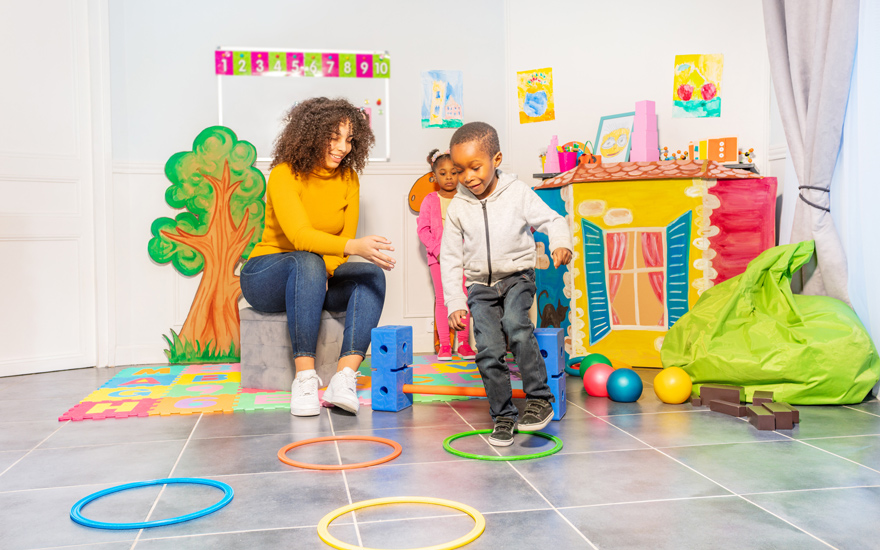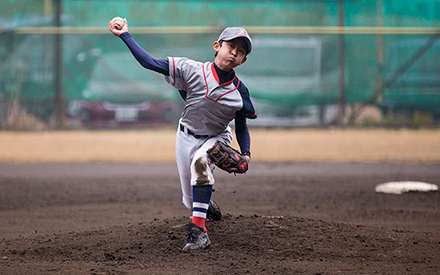
Play has an important role in the growth and development of all children. Through play, children develop thinking, movement, and communication skills in a fun and engaging way. These skills contribute to a child's overall emotional regulation and well-being. Play is particularly valuable for children with special needs. According to the Centers for Disease Control and Prevention, nearly 1 in 10 children in the United States ages 3 to 17 has one or more developmental disabilities.
Pediatric physical therapists use play and movement to help families achieve functional goals for their children. Physical therapists can provide ideas for ways that families can play together, regardless of a child's ability level.
Choosing the right toy is a great place to start. Pediatric physical therapists recommend toys that promote physical development and support social engagement and thinking skills.
Choosing the Right Toy
The following steps can help with finding suitable toys:
- Identify the child's play ability and consider their needs and likes.
- Consider the skills a toy can help expand or develop.
- Consider toys that encourage interaction with others.
- Consider toys that are "open-ended" and can be used in various ways.
- Carefully review toys for safety.
While not all-inclusive, the following tips can help you find enjoyable and helpful toys for children with different conditions.
Toy Ideas for Children With Autism
To support your child's development, choose toys that have a purpose, such as promoting and encouraging the following skills:
- Imitation of movements.
- Turn taking.
- Using both sides of their body together.
Prioritize toys that don't need batteries. Toys without sounds or lights better support creativity and engagement with others. Examples include:
- Brightly colored toys such as puzzles, blocks, and other building toys.
- For younger children. Toy ideas include MEGA BLOKS, DUPLO blocks, toddler pop beads, chunky puzzles, or cardboard building blocks.
- For older children. Examples include LEGO blocks, Plus-Plus blocks, Zoobs, Magnetic tiles, and K'NEX.
- Picture cards and story books, yoga flashcards, Ready Set Move activity set, books featuring animal movements, or movement-oriented board games (such as Hullabaloo or Twister).
- Foam wedges, mats, tunnels, and beanbags for climbing, moving, jumping, and crashing.
- Partner throwing game sets, such as trampoline paddle ball, VELCRO toss and catch, Trac-ball, beanbag toss, VELCRO darts, bowling, and bocce ball.
Toy Ideas for Children Learning to Crawl, Stand, or Walk
Choose toys that encourage changing positions and moving around. Examples include:
- Baby-safe cars, trucks, and trains.
- Rolling toys like balls and cylindrical baby toys.
- Stacking cups.
- Stacking rings to spin, roll, and collect.
- Kid-friendly support surfaces. Examples include a low bench or coffee table, a sturdy easel, a play kitchen or workbench, a water table, or a train table.
- Toys with pieces and parts that can be placed to encourage standing up, squatting down, and cruising along furniture. Examples include shape sorters, chunky puzzles, and Little People play sets.
- Stable push toys like wooden carts, shopping carts, and ride-on combo toys with push handles. Many children enjoy pushing items already available around the home. These can include things such as a weighted laundry basket or an unopened box of diapers.
Toy Ideas for Children Who Use Mobility Devices
Choose toys that your child can manipulate and activities to help them develop arm and leg strength. Examples include:
- Activities such as:
- Pegboard games (such as LiteBrite).
- Arts and crafts kits, kneading materials (such as Silly Putty and Play-Doh).
- Building and science or engineering-focused toys (such as Playstix®, Snap Circuits®) and magnetic toys.
- Kites are fun for children of all mobility levels and encourage outdoor playtime.
- Wheelchair or walker accessories create opportunities for play and enthusiasm for getting outside. Clip-on baskets or buckets are useful for collecting scavenger hunt items or outdoor treasures. Water bottle holders are great for athletes. Children can personalize their devices while using their hands to apply spoke skins, vinyl stickers, and bendable plush flowers.
- Obstacle course materials for practicing wheelchair navigation skills in a fun way. Use colored cones, pool noodles, hula hoops, and PVC to create various obstacles. Use sidewalk chalk, jump ropes, or pool noodles to create paths. Purchase a musical welcome mat or a floor mat piano for a fun finish.
For those who use wheelchairs. Try a basketball hoop or T-ball set with adjustable height or other games that involve throwing, such as a football/ring set or Velcro darts, to encourage upper-body use. Easier options include stringy sensory balls that are fun to catch, punch balloons, and beanbag toss sets.
For those who use walkers or gait trainers. A Stomp Rocket set or kicking games using soccer balls, balloons, or beach balls can encourage lower body movement and play.
Toy Ideas for Children With Low Muscle Tone
Choose toys that encourage muscles to stay "turned on" or active. Examples include:
- Bouncy or rocking seated toys, such as a rocking horse, Rody horse, rocking discs, hopper ball with handle, or climbing arch that flips over into a rocker.
- Active sitting tools for use at a child's play table or desk. These can include options like a wobble stool, an exercise ball chair, or an inflatable wiggle cushion (such as the CanDo wedge or wobble disc).
- Toys to pull apart and push together. There are toys available, such as pull-apart fruits and veggies, pop beads, magnetic toys, large pop tubes, bristle blocks, or waffle blocks.
- Indoor and outdoor climbing equipment that matches your child's age and ability. This might mean a set of foam mats and blocks, a Pikler triangle, a wall climber, a play dome, or a swing set.
Toy Ideas for Children Working on Coordination
Choose toys that encourage using arms and legs on both sides of the body. Examples include:
- Movement toys that work the upper body. Examples include Sit'N Spinr, scooter board, PlasmaCar, or Roller Racer.
- Obstacle course equipment. Ideas include balance beam pieces, stepping stones, over or under hurdles, agility rings, air-filled balance pods, and tunnels.
- Outdoor riding toys with pedals. These include a standard tricycle, a bicycle with training wheels, or a three-wheeled scooter with lean-to-turn steering (two wheels in front for more stability).
Additional Resources
- Podcast: Mothers Ellen Seidman and Jennifer Byde Myers discuss raising children with special needs, including the role of physical therapy in their children's development. During the podcast, a physical therapist offers additional advice. Listen to this Move Forward Radio episode.
More About Pediatric Physical Therapy
Early intervention by a pediatric physical therapist can benefit children with:
- Autism spectrum disorder.
- Cerebral palsy.
- Down syndrome.
- Developmental coordination disorder.
- Developmental delays.
- Torticollis.
Learn more about these and other conditions that pediatric physical therapists treat by visiting the Physical Therapy Health Center for Children.
Physical therapists are movement experts who improve quality of life through hands-on care, patient education, and prescribed movement. You can contact a physical therapist directly for an evaluation. To locate a physical therapist in your area, visit Find a PT.


